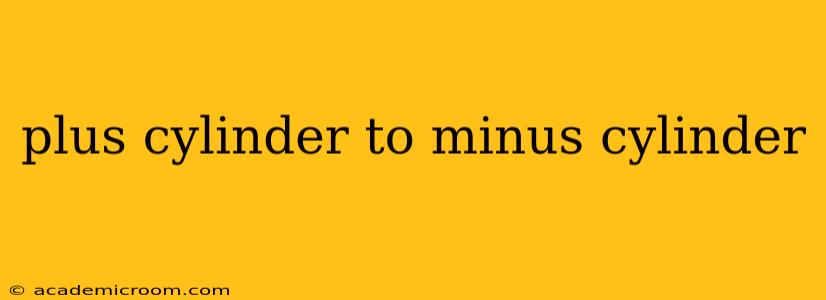Changing from a plus cylinder to a minus cylinder in your eyeglass prescription signifies a shift in the type of astigmatism you have or how your astigmatism is being corrected. This can be a confusing change, so let's break down what it means and address some common questions.
What is Astigmatism?
Before diving into the plus-to-minus cylinder shift, it's crucial to understand astigmatism. Astigmatism is a refractive error where the cornea (the clear front part of your eye) is irregularly shaped. This irregular shape prevents light from focusing correctly on the retina, leading to blurry vision at all distances. Eyeglass prescriptions correct astigmatism using cylindrical lenses, indicated by the "cyl" or "x" value.
Plus Cylinder vs. Minus Cylinder: What's the Difference?
The plus (+) or minus (-) sign in front of the cylinder power denotes the orientation of the astigmatism. It doesn't directly represent the severity; that's indicated by the numerical value itself. The difference lies in how the lens corrects the irregular curvature of the cornea.
-
Plus Cylinder (+ Cyl): Corrects for astigmatism where the cornea is steeper in one meridian (direction) than the other. Think of it like an egg shape – steeper in one direction and flatter in the other.
-
Minus Cylinder (- Cyl): Corrects for astigmatism where the cornea is flatter in one meridian than the other. The correction is achieved by flattening the steeper meridian.
The change from plus to minus isn't a simple increase or decrease in astigmatism's severity; it's a change in the method of correction. Your eye doctor chooses the sign based on the best way to achieve clear vision with the least amount of lens power. Sometimes, a minus cylinder might offer a more efficient correction than a plus cylinder, even if the underlying astigmatism remains similar.
Why Would My Prescription Change from Plus Cylinder to Minus Cylinder?
Several reasons might lead to this alteration in your prescription:
-
Refining the correction: Your doctor might have found a slightly more efficient way to correct your astigmatism with a minus cylinder, resulting in sharper vision and potentially more comfortable lenses.
-
Changes in your astigmatism: Although less common, your astigmatism itself could have subtly changed over time. The change in prescription reflects these subtle shifts.
-
Different measurement methods: Different devices or techniques used during eye exams might lead to slightly different measurements. This could result in a prescription change, even if your astigmatism has remained relatively constant.
-
New lens technology: Advances in lens technology might enable more accurate and effective correction with a minus cylinder.
How Does This Affect My Vision?
The impact on your vision depends on the magnitude of the change. A small shift might be imperceptible, while a larger change could affect clarity and comfort. If you experience any issues after the change, contacting your ophthalmologist is crucial.
Will This Mean My Astigmatism Is Getting Worse?
Not necessarily. The change from plus to minus cylinder doesn't automatically mean your astigmatism is worsening. It's more likely a refinement of the correction method to optimize your vision.
What Should I Do If My Prescription Changes?
If your prescription changes from plus to minus cylinder, don't worry unnecessarily. The most important thing is to communicate openly with your eye care professional. They can explain the reasons for the change and ensure the new prescription provides optimal vision and comfort.
Remember, regular eye exams are crucial for maintaining good vision health. Any changes in your prescription should be discussed with your doctor to ensure you're getting the best possible care.
